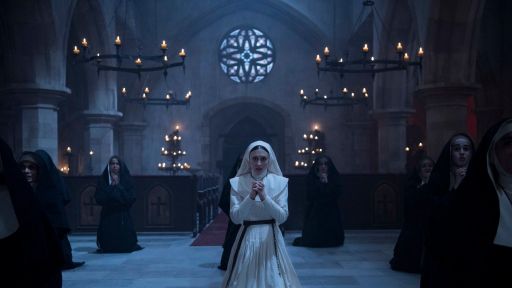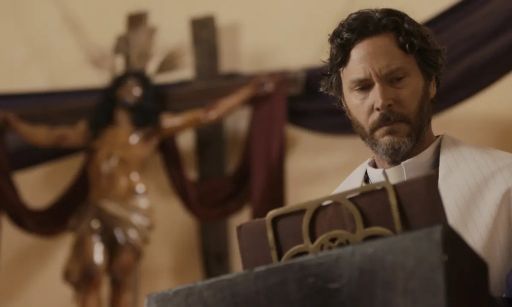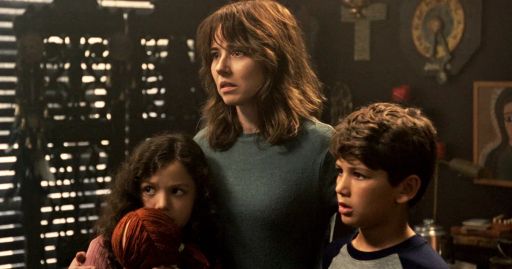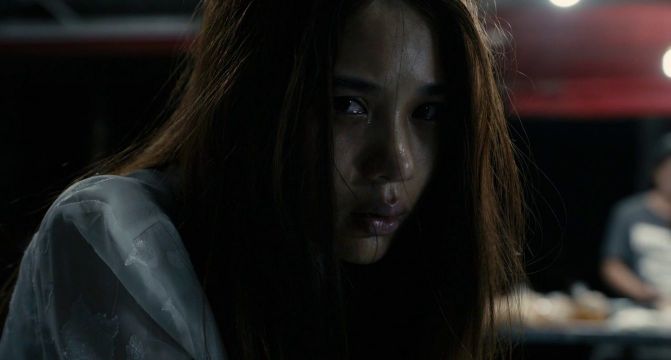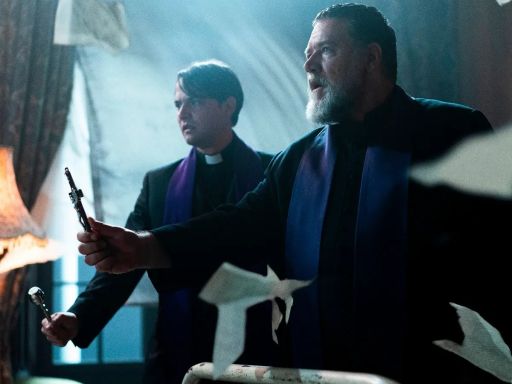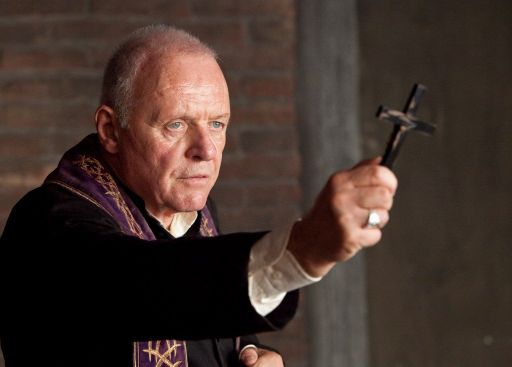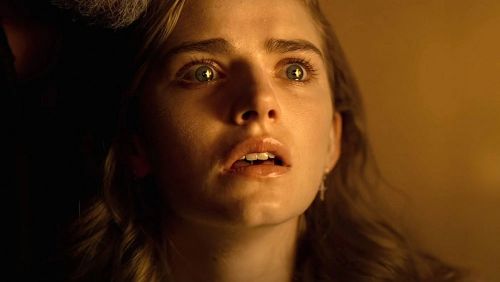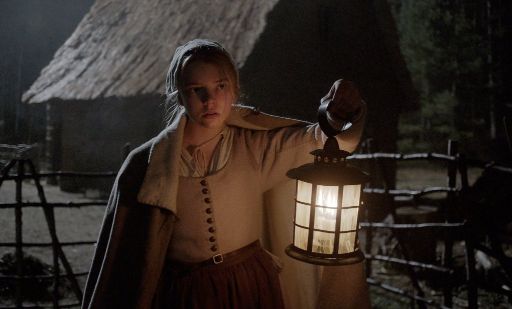The Nun, a horror film from Corin Hardy, presses the pommel of time’s dagger and transports us to the early 1950s. The story, which is set in the world of “The Conjuring,” develops as Father Anthony Burke (Demián Bichir) and a young nun named Irene (Taissa Farmiga) travel to Saint Cartha’s monastery in Romania to look into a sister’s suicide. There, they come face to face with a demonic entity that has assumed the form of a nun, which causes them to question their very faith. Along with Jonas Bloquet, Bonnie Aarons, and Demián Bichir, who play important roles, the cast also includes Taissa Farmiga as Irene and Demián Bichir as Father Burke.
This ‘The Conjuring 2’ prequel is unique in that its horror component questions Christianity itself. The Church is the target, and in some ways it appears that it equates being possessed (by a demon) with yielding to a greater power—clearly God. If you approach it from a broader perspective, it is the actual existence of evil inside God’s sanctuary. Nothing could be worse. But can it? Here are some scary films we think can help you find the solution. Most of these ‘The Nun’-inspired films are available on Netflix, Hulu, or Amazon Prime.
Incantation (2022)
Taiwanese horror film “Incantation,” directed by Kevin Ko, uses God as the main motif of fear rather than evil. A six-year-old curse is currently plaguing Li Ronan’s kid. She is the one who awoke it by breaking the rules and going through a tunnel. She asks the audience to recite a “incantation” in order to assist her in removing the curse from her daughter.
The curse and its origin, whose primary cause is a god, Mother Buddha, as well as the shattering of the fourth wall helped to distinguish the film from the competition. In a manner that is just as terrifying as in “The Nun,” the film attempts to blur the lines between good and evil by illustrating how surrender can occasionally turn into possession.
The Exorcism of God (2021)
The storyline of Alejandro Hidalgo’s film “The Exorcism of God” elevates the test of faith as Father Peter Williams (Will Beinbrink), who has already experienced possession in the past that caused him to sin, travels to a small Mexican town only to encounter the same demon 18 years later. Esparanza (Mara Gabriela de Fara), a young woman, is its victim this time around. Peter will need to repent of the sin he did in order to save her—a sin that calls into serious question both his faith and religion. The movie depicts a demon assuming the form of Jesus only to reinstate the theme of doubting faith and the absence of the Almighty, reminding us that “God ends here” in fact. This film and “The Nun” are related by the idea of the absence of God.
The Curse of La Llorona (2019)
Michael Chaves is responsible for the direction of “The Curse of La Llorona.” Linda Cardellini’s character, Anna Tate-Garcia, is a mother of two who disregarded the warning cries of Patricia Velasquez, a mother who had recently lost her two young children, only to have her own children come under the control of an evil spirit. They appear to be under a curse, and the endless conflict between good and evil then reappears.
For those of you who are unaware, the film is set in the Conjuring world. Now, discounting this reality, what ties the two films together is their emphasis on women. Even the villains, Valak and La Llorona, are depicted as female in “The Nun” and “The Curse of La Llorona,” respectively, in addition to the main characters, Irene and Anna. It is simple to assert that the two opposing forces’ increased purity contributes to their organic metaphysical battle.
The Medium (2021)
Banjong Pisanthanakun directed this Thai horror film. It centres on Nim (Sawanee Utoomma), who considers herself to be a shamaness who has been taken over by the goddess Ba Ya. Nim believes that her niece Mink (Narilya Gulmongkolpech) is prepared to receive Ba Ya’s spirit from her when she starts to exhibit odd behaviours. Is she actually? Or has she become controlled by something else? This movie incorporates religion into the storyline in a way that may go beyond what “The Nun” does. We are compelled to question the God in question’s very existence.
The Pope’s Exorcist (2023)
This horror film, which was directed by Julius Avery, was based on actual incidents that Father Gabriele Amorth (Russell Crowe), the main exorcist for the Diocese of Rome, wrote about in his memoirs. Amorth is dispatched to Spain to investigate the belongings of a little boy named Henry (Peter DeSouza-Feighoney), who recently moved into an abbey that their late father had left for them. Amorth tries to exorcise the devil out of the boy with the help of a local priest by the name of Esquibel (Daniel Zovatto), but is unsuccessful. He quickly learns that the possession is connected to a secretive period in the abbey’s history that dates to the Spanish Inquisition and which the Church covered up.
The church is involved in the struggle against evil in “The Pope’s Exorcist,” just like in “The Nun.” In a manner, we could say that God is under scrutiny, and this is really the concept of “The Nun.” Do you recall the door’s writing, “God ends here”? ‘The Pope’s Exorcist’ doesn’t have any writing, but it does make it abundantly evident that fighting the devil’s strength requires more than just faith in God, especially when His authority is nowhere to be found.
The Rite (2011)
The Rite, which stars Colin O’Donoghue, Anthony Hopkins, and Toby Jones, was helmed by Mikael Hfström. The story develops as we watch sceptic deacon Michael (O’Donoghue) be persuaded by Father Matthew (Jones) to study exorcism at the Vatican, where he meets Father Lucas (Hopkins). As a result of Lucas’ involvement in the ‘purification’ of a little girl, Michael’s mistrust of Good and Evil and his lack of faith are called into doubt. He will have to yield to faith when the girl’s condition gets worse. Can he really accomplish that?
This film examines the relationship between good and evil from the other side; it is a test of one’s faith, and if one fails, evil will ultimately triumph. When ‘The Nun’ is compared to this film, it is because both are about two strong forces vying for supremacy over one another. Additionally, it is a test of Michael’s faith similar to what Irene faces in “The Nun.”
The Unholy (2021)
The most graphic depiction of a demon posing as God’s Mother, the Virgin Mary, may be found in Evan Spiliotopoulos’ film “The Unholy.” After an alleged visit from the Virgin Mary in Banfield, Massachusetts, Alice (Cricket Brown), a young deaf woman, suddenly recovers and gains the ability to treat the sick. Journalist Gerry Fenn (Jeffrey Dean Morgan), who is searching for a breaking story, tries to investigate further but becomes uncertain as to whether the Virgin Mary is in her or something much less benign, if not evil. The themes of doubting one’s religion are explored in both “The Unholy” and “The Nun.” However, by demonstrating how a demonic entity deceives people into believing that it is a God in order to take advantage of them, the former increases the standard that the latter sets.
The Witch (2015)
The narrative of “The Witch,” which is set in 17th-century England, was directed by Robert Eggers. It tells the tale of a Puritan family, including parents William (Ralph Ineson) and Katherine (Kate Dickie), and their children Thomasin (Anya Taylor-Joy), Caleb (Harvey Scrimshaw), Mercy (Ellie Grainger), and Jonas (Lucas Dawson), who are expelled from their community due to religious disagreements and settle in the vicinity of a forest. They already have four children, and in their new house, the woman gives birth to a fifth. Sadly, Samuel the infant unexpectedly vanishes.
Unbeknownst to the family, this absence is merely the start of a string of paranormal occurrences that would include Caleb’s passing, a deal with a goat, and the disappearance of further family members. There are several parts of the movie that link it to the God vs. Devil concept as seen in “The Nun,” from being exiled because of religious differences to the deal with a goat that is a symbol of the devil (particularly in witchcraft) and the movie’s title.

